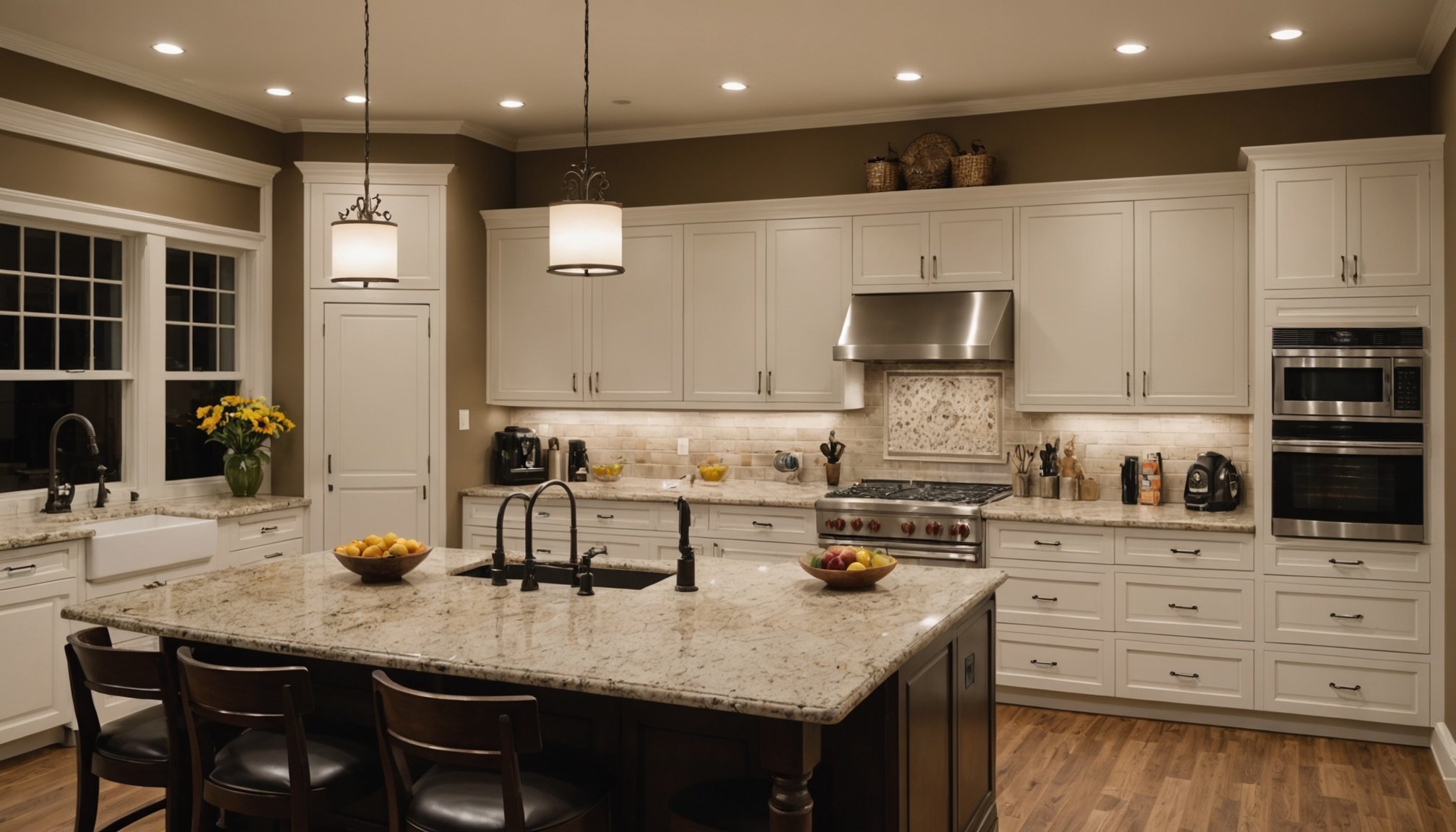Transform Your Kitchen with Expert Lighting Tips: Eliminate Glare for the Perfect Ambiance
When it comes to kitchen design, lighting is often the unsung hero that can make or break the ambiance and functionality of the space. Proper kitchen lighting not only enhances the aesthetic appeal but also ensures that your kitchen is a comfortable and efficient place to cook, socialize, and spend time. Here’s a comprehensive guide on how to transform your kitchen with expert lighting tips, focusing on eliminating glare and creating the perfect ambiance.
Understanding the Layers of Kitchen Lighting
To create an ideal lighting scheme in your kitchen, it’s crucial to understand the three primary layers of lighting: task, ambient, and accent lighting.
Additional reading : Transform Your Kitchen: Harness Energy Efficiency with Smart Designs for Peak Usage Times
Task Lighting
Task lighting is designed to illuminate specific work areas, such as countertops, sinks, and cooking stations. This type of lighting helps reduce eye strain and improves safety by providing focused light where it is most needed.
- Under Cabinet Lights: LED strips or puck lights placed under cabinets are excellent for task lighting. They illuminate the countertops and reduce shadows, making food preparation easier[2][5].
- Recessed Downlights: These can be positioned above key work areas to provide direct light without creating glare.
- Track Lighting: Adjustable track lights can be directed towards specific tasks, such as cooking or food prep.
Ambient Lighting
Ambient lighting sets the overall mood and provides general illumination to the room. It helps to create a warm and inviting atmosphere.
Also to see : Mastering Spice Storage: Creative Kitchen Design Solutions for Optimal Organization
- Ceiling Fixtures: Central ceiling lights or chandeliers can provide a soft, even glow throughout the kitchen.
- Wall Sconces: Strategically placed wall sconces can add a warm ambiance and fill in any dark areas.
- Natural Light: During the day, natural light can serve as ambient lighting. Consider using sheer curtains or blinds to filter the light and reduce glare[5].
Accent Lighting
Accent lighting highlights specific features or decorative elements in the kitchen, such as open shelving, a statement backsplash, or a kitchen island.
- Pendant Lights: Hanging pendant lights above a kitchen island or breakfast nook can serve as both task and accent lighting. They add a sculptural element and can be adjusted to highlight specific areas[1][5].
- Picture Lights: These can be used to highlight decorative elements like artwork or a beautifully designed backsplash.
- Shelf Lights: LED lights placed under shelves can create a warm glow and draw attention to the items on display.
Choosing the Right Fixtures for Your Kitchen
The type of lighting fixtures you choose can significantly impact the overall design and ambiance of your kitchen.
Decorative and Statement Pendant Lights
Pendant lights are a popular choice for kitchens, especially above kitchen islands or breakfast nooks. They add a sculptural element and can be chosen to reflect the style of your kitchen.
- Optimal Height: Hang pendant lights at an optimal height of around 30-36 inches above the island to provide sufficient light without obstructing views[1].
- Material and Design: Choose pendant lights made from materials that align with your kitchen’s style, whether it’s modern, industrial, or traditional.
Lighting with Natural Materials and Forms
Incorporating natural materials and forms into your lighting design can add warmth and texture to your kitchen.
- Organic Materials: Use lighting fixtures made from organic materials like rattan, wood, or linen shades. These materials bring a softer, more natural feel to the space[1].
- Earthly Tones: Pair these natural finishes with neutral color palettes or bold, earthy tones to create a timeless yet trendy aesthetic.
Layered Lighting Designs
Layered lighting is a trend that is gaining popularity in kitchen design. It involves combining different types of lighting to create a balanced and inviting atmosphere.
How to Layer Your Lighting
To layer your lighting effectively, start with task lighting to illuminate key work areas. Then, add ambient lighting to fill the room with a soft glow. Finally, use accent lighting to highlight decorative elements.
- Task Lighting First: Use under-cabinet LED strips or recessed downlights to illuminate countertops and the sink.
- Ambient Lighting Next: Add ceiling fixtures or wall sconces to provide a soft, even glow.
- Accent Lighting Last: Use pendant lights, picture lights, or shelf lights to highlight architectural features or decorative elements[1].
Smart Home Kitchen Lighting Solutions
Smart home lighting solutions can add a level of convenience and flexibility to your kitchen lighting scheme.
Integration with Smart Home Systems
Smart lighting can be integrated into your existing smart home system, allowing you to control the lights from an app, set timers, and adjust brightness and color temperature.
- Under Cabinet Strip Lights: These can be synced with your smart home system and adjusted for brightness and color temperature. They are also easy to install and can be hidden behind cabinets to maintain a clean look[2].
- Dimmable Lights: Dimmable lights are essential for creating a versatile lighting scheme. They allow you to adjust the brightness to suit different activities and times of the day.
Avoiding Common Lighting Mistakes
When designing your kitchen lighting scheme, it’s important to avoid common mistakes that can lead to glare, uneven lighting, and an uninviting atmosphere.
Common Mistakes to Avoid
Here are some common mistakes to watch out for:
- Insufficient Task Lighting: Not providing enough light over work areas can lead to eye strain and accidents.
- Solution: Ensure that each work area has dedicated task lighting.
- Overuse of Recessed Lights: Too many recessed lights can create harsh glare.
- Solution: Balance recessed lights with ambient and accent lighting.
- Incorrect Placement of Pendant Lights: Hanging pendant lights too high or too low can affect their functionality.
- Solution: Hang pendant lights at an optimal height of around 30-36 inches above the island[4].
Practical Tips for Installing Kitchen Lighting
Installing kitchen lighting can be a DIY-friendly project if you follow some practical tips.
Step-by-Step Installation Guide
Here’s a step-by-step guide to installing under-cabinet lighting, a common and effective kitchen lighting solution:
- Choose the Right Lights: Select under-cabinet strip lights or puck lights that fit your design and functional needs.
- Prepare the Area: Clean the area under the cabinets to ensure the lights adhere properly.
- Plug-In and Connect: Plug in the lights and connect them to a power source. Feed the tape light through a drilled hole and mount it on the interior side of the cabinet[2].
- Apply the Lighting Strip: Pull off the backing to reveal the adhesive and stick the tape light onto the desired location. Tuck it up behind the cabinets for a diffused look.
- Sync with Smart Home: If using smart lights, sync them with your smart home app to control brightness, color temperature, and scheduling.
Table: Comparing Different Kitchen Lighting Options
| Lighting Type | Description | Advantages | Disadvantages |
|---|---|---|---|
| Pendant Lights | Hanging lights above kitchen islands or breakfast nooks. | Adds a sculptural element, provides task and accent lighting. | Can obstruct views if hung too low. |
| Under Cabinet Lights | LED strips or puck lights placed under cabinets. | Provides focused task lighting, easy to install. | Can create glare if not positioned correctly. |
| Recessed Downlights | Lights installed into the ceiling. | Provides direct light, reduces shadows. | Can create harsh glare if overused. |
| Wall Sconces | Lights mounted on walls. | Adds ambient lighting, fills dark areas. | May not provide sufficient light for task areas. |
| Smart Lighting | Lights integrated with smart home systems. | Adjustable brightness and color temperature, convenient control. | Requires initial setup and investment. |
Quotes from Experts
- Ryan Smith, Chief Creative Officer at LightArt: “As the kitchen has evolved to become the main feature and modern gathering space, these types of decorative, statement-style fixtures have become a real centerpiece for most kitchens.”
- David Amos, Director at Amos Lighting: “Kitchens are no longer just functional spaces – they’re the heart of the home. Layered lighting designs that combine task, ambient, and accent lighting will dominate, ensuring practicality while creating a warm, inviting atmosphere.”
Creating the Perfect Ambiance
The perfect ambiance in your kitchen is a balance of functionality and aesthetics. Here are some final tips to help you achieve this:
- Consider Natural Light: During the day, natural light can be a significant source of ambient lighting. Use sheer curtains or blinds to filter the light and reduce glare.
- Mix and Match: Don’t be afraid to mix different lighting styles and materials to create a unique and inviting space.
- Dimmable Lights: Use dimmable lights to adjust the brightness according to the time of day and the activity you are performing.
- Warm Lighting: Opt for warm lighting options, especially in the evening, to create a cozy and welcoming atmosphere.
By following these expert tips and avoiding common lighting mistakes, you can transform your kitchen into a space that is not only functional but also beautifully lit and inviting. Whether you’re looking to update your existing kitchen or design a new one, the right lighting scheme can make all the difference in creating the perfect ambiance for your home.

